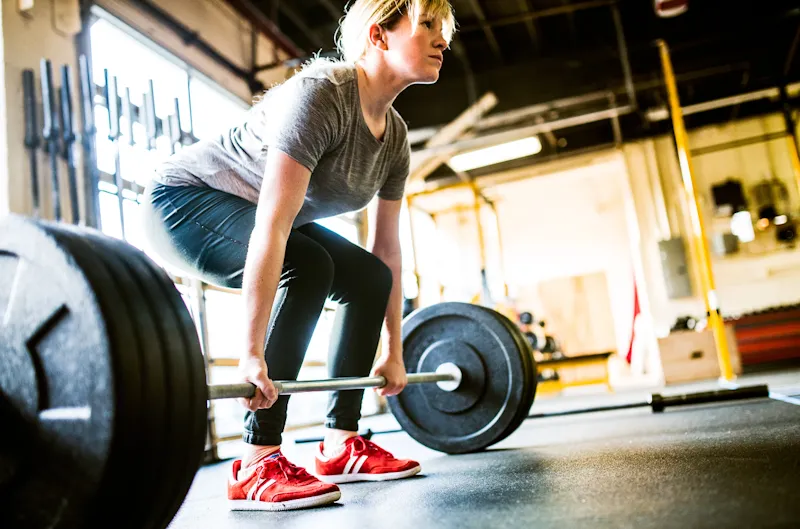Top 10 Essential Tips for Strength Building for Women

What's In This Article
- Key Highlights
- Introduction
- 10 Vital Strategies: Strength Building for Women
- Strength Training with Powerlifting Techniques
Key Highlights
- Strength training benefits women as it improves overall strength, reduces the risk of injury, helps combat age-related muscle loss, aids in weight management, improves posture, and promotes longevity.
- Strength training is not just for men. Women can lift weights without getting bulky. Strength training can help women achieve a toned physique depending on individual goals.
- Strength training can be done at home with bodyweight exercises or at the gym with equipment like dumbbells and barbells.
- Proper form and technique are crucial for effective and safe strength training. Start with lighter weights and gradually increase the intensity.
- Rest and recovery, nutrition, and goal setting are integral parts of strength training for women.
- Powerlifting techniques, such as deadlifts, squats, and bench presses, can be incorporated to maximize strength gains.
Introduction
Strength training is not just for men. Women can benefit greatly from incorporating resistance training into their fitness routine. It helps build overall strength, improves bone density, reduces the risk of injury, and promotes a toned physique. In this blog, we will discuss 10 essential strength building tips for women, including incorporating compound movements, progressive overload, rest and recovery, proper nutrition, and mastering form and technique, focusing on the importance of resistance training.
Whether you are a beginner or have been resistance training for a while, these tips will help you optimize your workouts and achieve your fitness goals. Resistance training is not about becoming bulky or masculine; it's about building strength, improving muscle definition, and boosting overall health and well-being.

10 Vital Strategies: Strength Building for Women
Strength training is a key component of any fitness routine for women. By incorporating these 10 vital strategies, you can optimize your training efforts and achieve the desired results.
- Incorporating Compound Movements into Your Routine: Compound movements, such as squats, deadlifts, and bench presses, engage multiple muscle groups simultaneously, leading to efficient muscle building and strength gains.
- Perfecting the Art of Progressive Overload: Progressive overload involves gradually increasing the intensity of your workouts by lifting heavier weights, increasing the number of repetitions, or reducing rest time. This method stimulates muscle growth and improves overall strength.
- Understanding the Importance of Rest and Recovery: Rest and recovery are essential for muscle repair and growth. Aim for at least one rest day between strength training sessions to allow your muscles to recover and adapt to the stress of exercise.
- Balancing Nutrition for Optimal Gains: Proper nutrition is crucial for muscle building and strength development. Ensure you consume adequate protein, carbohydrates, and healthy fats to provide your body with the necessary fuel and nutrients.
- Mastering Bodyweight Exercises Before Adding Weights: Bodyweight exercises, such as push-ups, squats, and lunges, are an excellent starting point for building strength. Mastering proper form and technique with bodyweight exercises will lay a solid foundation for adding weights later.
- Learning Proper Form and Technique: Correct form and technique are essential for effective and safe training. Take the time to learn the proper form for each exercise to maximize results and minimize the risk of injury.
- Implementing Functional Training into Workouts: Functional training focuses on exercises that mimic everyday movements to improve overall strength and functionality. Incorporating functional exercises like lunges and planks into your workouts can enhance your overall strength and stability.
- Emphasizing Core and Stability: A strong core is vital for overall stability. To improve core strength and enhance overall performance, incorporate exercises that target the core, such as planks and Russian twists.
- Exploring Powerlifting Techniques: Powerlifting techniques, such as deadlifts, squats, and bench presses, can be incorporated to maximize gains. These compound movements engage multiple muscle groups and promote overall strength development.
- Setting Realistic Goals and Tracking Progress: Setting realistic goals and tracking your progress is essential for staying motivated and consistently challenging yourself. Set specific, measurable, attainable, relevant, and time-bound (SMART) goals and track your progress to ensure continuous improvement and success in your strength training journey.
1. Incorporating Compound Movements into Your Routine
One of the most effective strategies for building muscle is incorporating compound movements into your routine. Compound movements involve multiple muscle groups and joints, resulting in greater muscle activation and overall muscle development.
For the upper body, compound movements such as bench presses, push-ups, and pull-ups simultaneously engage the chest, shoulders, triceps, and back muscles. These exercises build muscle and improve muscle definition and upper body aesthetics.
Compound movements like squats, lunges, and deadlifts for the lower body target the quadriceps, hamstrings, glutes, and calves. These exercises build lower body muscle and improve balance and stability.
Incorporating compound movements into your routine allows you to work multiple muscles simultaneously, leading to more efficient workouts and greater muscle mass and strength gains. Whether you are a beginner or an experienced lifter, compound movements should be a fundamental part of your muscle training program. To maximize the benefits of compound movements, don't be afraid to challenge yourself with heavier weights as you progress.

2. Perfecting the Art of Progressive Overload
Progressive overload is a fundamental principle of strength training that involves gradually increasing the stress on your muscles to stimulate growth gains. By consistently challenging them with increased resistance or intensity, you force your muscles to adapt and become stronger over time.
Progressive overload can be incorporated into your training routine in several ways. One method is to gradually increase the weight you lift for each exercise. For example, if you squat with 50 pounds, aim to increase the weight by 5 pounds each week.
Another method is to increase the repetitions or sets you perform for each exercise. By gradually increasing the volume of your workouts, you provide additional stimulus to your muscles, prompting them to grow and strengthen.
Additionally, you can decrease the rest time between sets or increase the intensity of your exercises by incorporating advanced variations or techniques. For example, you can perform a squat with a jump or add resistance bands to your push-ups.
Remember to listen to your body and progress at a challenging but manageable pace. Pushing yourself too hard or too quickly can increase the risk of injury. By gradually increasing the demands on your muscles, you can continue to progress and achieve your goals.
3. Understanding the Importance of Rest and Recovery
Rest and recovery are essential components of any training program. When you train, you create micro-tears in your muscle fibers. During the rest and recovery period, your muscles repair and rebuild, resulting in increased strength and muscle growth.
Adequate rest allows your body to replenish energy stores, remove metabolic waste products, and repair damaged tissues. During rest, your body adapts to the stress of exercise and becomes stronger.
In addition to physical rest, sleep is also crucial for muscle recovery and growth. During sleep, your body releases growth hormones, aiding tissue repair and muscle development. Aim for 7-9 hours of quality sleep per night to optimize muscle recovery.
Proper nutrition is also important for muscle recovery. Ensure you consume enough protein, as it provides the building blocks for muscle repair and growth. Additionally, consuming a balanced diet of fruits, vegetables, whole grains, and healthy fats will provide the necessary nutrients for optimal recovery.
Remember to listen to your body and take rest days as needed. Overtraining can lead to decreased performance, increased risk of injury, and impaired muscle recovery. By prioritizing rest and recovery, you can optimize your strength training results and minimize the risk of overuse injuries.

4. Balancing Nutrition for Optimal Strength Gains
Nutrition plays a crucial role in training and muscle building. To optimize gains, a balanced diet that provides the necessary nutrients for muscle growth and recovery is important.
Protein is a key nutrient for muscle building. Aim to consume around 0.8-1 gram of protein per pound of body weight daily. Good protein sources include lean meats, poultry, fish, eggs, dairy products, legumes, and plant-based protein sources like tofu and tempeh.
Carbohydrates are a vital source of energy for workouts. They provide the fuel your muscles need to perform at their best. Include complex carbohydrates like whole grains, fruits, vegetables, and legumes.
Healthy fats, such as avocados, nuts, seeds, and olive oil, are also important for optimal gains. They provide essential fatty acids, support hormone production, and aid muscle recovery.
It is also important to consume enough calories to support your training goals. If you want to build muscle, you may need to consume a slight surplus; if you are aiming for weight loss, you may need to create a calorie deficit. Consult with a registered dietitian or nutritionist to determine the best approach for your needs and goals. Incorporating ice water and green tea into your diet can also help boost your metabolism and calorie burn.
Remember to stay hydrated by drinking plenty of water throughout the day. Proper hydration is essential for muscle function and overall health.
5. Mastering Bodyweight Exercises Before Adding Weights
Mastering bodyweight exercises is an important step in building before progressing to weighted exercises. Bodyweight exercises allow you to develop proper form, technique, and body awareness, which is crucial for safe and effective training.
Bodyweight exercises target multiple muscle groups and promote overall stability. They require minimal equipment and can be done anywhere, making them convenient for training at home or while traveling.
Some key bodyweight exercises to master include push-ups, squats, lunges, planks, and burpees. These exercises engage the upper and lower body's major muscle groups and the core muscles.
Incorporate bodyweight exercises into your workout routine at least two to three times a week to build a solid foundation and prepare your body for more advanced exercises with weights. As you become more proficient in bodyweight exercises, you can gradually progress to using weights to challenge your muscles further and continue to make gains in muscle definition. It is important to start with straight sets when incorporating weights, doing one set of exercises before moving on to the next to build and avoid injury properly.

6. Learning Proper Form and Technique
Learning proper form and technique is essential for effective and safe training. Using proper form ensures that you are targeting the intended muscles and minimizing the risk of injury.
Start with lighter weights or bodyweight exercises to focus on mastering the correct form. Lighter weights with proper form are better than heavier weights with poor form.
Engage your core muscles, maintain a neutral spine, and use a full range of motion for each exercise. Avoid using momentum or relying on other muscle groups to complete the movement.
When using free weights, such as dumbbells or barbells, ensure you have a firm grip and control the weight throughout the movement. Practice proper breathing techniques, exhaling during the exertion phase and inhaling during the relaxation phase.
Consider working with a certified personal trainer or strength coach to learn proper form and technique. They can provide guidance, corrections, and personalized recommendations to help you maximize the benefits of your training workouts.
Remember that quality is more important than quantity in strength training. Focus on performing each exercise with proper form and control to achieve the best results and minimize the risk of injury.
7. Implementing Functional Training into Workouts
Functional training focuses on exercises that mimic everyday movements and activities, improving overall strength, stability, and mobility. Implementing functional exercises into your training routine can enhance your performance in daily activities and sports.
Functional exercises target multiple muscle groups and require coordination and balance. Examples of functional exercises include squats, lunges, deadlifts, kettlebell swings, and medicine ball throws.
Incorporating functional exercises into your workouts can improve overall strength, stability, and flexibility in the muscles and joints used in daily activities. This can make carrying groceries, climbing stairs, or playing sports easier and more enjoyable.
To implement functional training into your training routine, choose exercises that target specific muscle groups and movement patterns relevant to your daily activities or sports. Focus on performing the exercises with proper form and control, gradually increasing the weight or resistance as you become stronger.
Listen to your body and choose exercises appropriate for your fitness level and goals. Consult with a fitness professional if you are unsure how to incorporate functional training into your training routine.

8. Emphasizing Core Strength and Stability
Core strength and stability are vital for overall and proper movement mechanics. Emphasizing core exercises in your training routine can improve posture, prevent injuries, and enhance overall performance.
The core muscles include the muscles of the abdomen, lower back, and hips. Strong core muscles provide a stable base for movement and help transfer force between the upper and lower body.
Incorporate exercises that target the core, such as planks, Russian twists, and cable crunches. Focus on performing these exercises properly, engaging the core muscles throughout the movement.
It is important to note that core strength is not just about six-pack abs. Strong core muscles also include the muscles that stabilize the spine and pelvis. You can improve balance, stability, and overall functional movement by strengthening the core.
Remember to progress gradually with core exercises, starting with basic exercises and gradually increasing the difficulty or resistance as you become stronger. Consult with a fitness professional to ensure proper form and technique and to receive personalized recommendations for core exercises that suit your fitness level and goals.
9. Exploring Powerlifting Techniques
Powerlifting techniques can be incorporated into your strength training routine to maximize strength gains and muscle development. Powerlifting focuses on three main lifts: the deadlift, squat, and bench press.
The deadlift is a compound exercise that targets the lower back muscles, glutes, hamstrings, and grip strength. It involves lifting a loaded barbell from the floor to a standing position.
The squat is another compound movement that targets the quadriceps, hamstrings, glutes, and core muscles. It involves lowering your body into a seated position and then pushing through the heels to return to standing.
The bench press targets the muscles of the chest, shoulders, and triceps. It involves lying on a flat bench and pushing a loaded barbell away from the chest.
Incorporating powerlifting techniques into your training routine can provide a new challenge and help you break through plateaus. Start with lighter weights and focus on mastering proper form and technique before increasing the weight.
Consider working with a powerlifting coach or trainer to learn the specifics of each lift and receive guidance on programming and progression. Powerlifting techniques can be valuable to your routine, helping you build overall strength and muscle mass.
10. Setting Realistic Goals and Tracking Progress
Setting realistic goals and tracking your progress is essential for staying motivated and continuously improving your training journey. Setting specific, measurable, attainable, relevant, and time-bound (SMART) goals allows you to stay focused and track your progress effectively.
Start by identifying what you want to achieve with your training. Whether it's increasing your bench press weight, achieving a specific bodyweight exercise, or improving your overall strength and muscle definition, set a meaningful goal.
Break your long-term goal into smaller, short-term goals that you can achieve along the way. For example, if your long-term goal is to perform a full push-up, your short-term goal could be to do knee push-ups and then progress to incline push-ups.
Tracking your progress is crucial for staying motivated and seeing your improvement over time. Keep a workout journal, use a fitness app, or take progress photos to document your journey. Celebrate your achievements along the way and adjust your goals as needed.
By setting realistic goals and tracking your progress, you can stay motivated, measure your success, and continue to improve your strength and muscle development.

Strength Training with Powerlifting Techniques
Powerlifting techniques can take your training to the next level and maximize your gains. Incorporating powerlifting movements such as the deadlift, squat, and bench press into your routine can provide unique benefits and challenges.
Powerlifting focuses on lifting heavy loads and emphasizes maximal power. These compound movements target multiple muscle groups and promote overall development.
By incorporating powerlifting techniques, you can challenge yourself with heavier weights, increase your muscle mass, and improve your overall performance. Remember to start with proper form and gradually increase the weight as you become more proficient in each movement.
Whether you are a beginner or an advanced lifter, powerlifting techniques can offer new opportunities for growth and progress in your training journey.
Understanding the Basics of Powerlifting
Powerlifting is a strength sport that focuses on three main lifts: the deadlift, squat, and bench press. These compound movements target multiple muscle groups and require a barbell and weights.
In powerlifting competitions, athletes aim to lift the heaviest weight possible in the three lifts: deadlift, squat, and bench press. The deadlift involves lifting a loaded barbell from the floor to a standing position. The squat involves lowering your body into a seated position and then pushing through the heels to return to standing, engaging your biceps. The bench press involves lying on a flat bench and pushing a loaded barbell away from the chest, utilizing your biceps.
Powerlifting techniques can be incorporated into your strength training routine to maximize strength gains and muscle development. Start with lighter weights and focus on mastering proper form and technique before increasing the weight.
Consult with a powerlifting coach or trainer to learn the specifics of each lift and receive guidance on programming and progression. Powerlifting techniques can add variety and challenge to your strength training routine, helping you build overall strength and muscle mass.
How Deadlifts Can Transform Your Strength Training
The deadlift is a compound exercise known as the king of exercises. It targets multiple muscle groups, primarily the muscles of the lower back, glutes, hamstrings, and grip.
Incorporating deadlifts into your training routine can transform your overall muscle development. By lifting heavy loads from the floor to a standing position, you engage and strengthen the posterior chain muscles.
Deadlifts are also effective for building muscle mass and improving overall body composition. They activate many muscles, including the glutes, hamstrings, quadriceps, erector spinae, and core.
Proper form and technique are essential when performing deadlifts to avoid injury and maximize results. Start with lighter weights and focus on mastering the correct form before gradually increasing the weight.
Consult with a certified coach to ensure proper technique and receive personalized recommendations for incorporating deadlifts into your routine. Deadlifts can be a game-changer for your training, helping you build overall muscle mass, and power.
The Role of Squats in Building Lower Body Power
Squats are among the most effective exercises for building lower body strength and power. They primarily target the quadriceps, hamstrings, glutes, and core muscles.
Incorporating squats into your strength training routine can significantly benefit your lower body development. Squats activate multiple muscle groups simultaneously, making them a highly efficient exercise for building overall lower body strength.
Squats also promote muscle hypertrophy and improve muscle definition in the lower body. They target the quadriceps, hamstrings, and glutes, key muscles for everyday movements like walking, running, and jumping.
Proper form and technique are crucial when performing squats to prevent injury and maximize results. Start with bodyweight squats to master the movement pattern, and gradually progress to using additional weights, such as dumbbells or barbells.
Consult a certified coach or personal trainer to ensure proper form and receive personalized recommendations for incorporating squats into your training routine. Squats can be a game-changer for your lower body and power, helping you achieve your fitness goals.

Nutrition and Recovery: Keys to Strength Building
Nutrition and recovery are crucial components of strength building. Proper nutrition provides the necessary fuel and nutrients for muscle recovery and growth, while adequate rest and recovery allow muscles to repair and adapt to exercise stress.
A balanced diet with adequate protein, carbohydrates, and healthy fats is essential for optimal muscle recovery and growth. Protein provides the building blocks for muscle repair, while carbohydrates provide energy for workouts and replenish glycogen stores. Healthy fats support hormone production and aid in nutrient absorption.
In addition to nutrition, proper rest and recovery are essential for muscle repair and growth. To support optimal muscle recovery and overall health, aim for 7-9 hours of quality sleep per night.
By prioritizing nutrition and recovery, you can optimize your strength-building efforts and more effectively achieve your fitness goals.
The Significance of Protein in Muscle Recovery
Protein plays a crucial role in muscle recovery and growth. It provides the essential amino acids that your body needs to repair and rebuild muscle tissue damaged during strength training.
When you strength train, you create micro-tears in your muscle fibers. Protein is necessary for repairing and rebuilding these damaged fibers, which leads to increased muscle mass and strength.
Consuming enough protein after your strength training workouts is essential for optimal muscle recovery. Aim to consume around 0.8-1 gram of protein per pound of body weight daily, depending on your individual needs and goals.
Good protein sources include lean meats, poultry, fish, eggs, dairy products, legumes, and plant-based protein sources like tofu and tempeh. Including a source of protein in each of your meals and snacks throughout the day can help ensure that you are providing your muscles with the necessary nutrients for recovery and growth at a faster rate. This is especially important for women, as we age and need to consume protein faster than our body breaks it down to maintain muscle mass.
Consult with a registered dietitian or nutritionist to determine the appropriate amount of protein for your individual needs and goals. Prioritizing protein intake can optimize muscle recovery and enhance strength-building efforts.
Carbohydrates and Fat: Fueling Your Strength Training
Carbohydrates and fat are important fuel sources for strength training and muscle recovery. They provide the energy your muscles need to perform at their best and support overall metabolic health.
Carbohydrates are the primary source of energy for intense strength training workouts. They are stored in your muscles as glycogen and provide the fuel your muscles need for contractions during exercise. Consuming adequate carbohydrates before and after your workouts can help replenish glycogen stores and support optimal muscle performance and recovery.
Healthy fats are also important for overall health and energy production. They provide a concentrated source of calories and serve as a backup fuel source when carbohydrates are limited. Including sources of healthy fats, such as avocados, nuts, seeds, and olive oil, can help provide sustained energy and support hormone production.
It is important to note that carbohydrates and fats contain calories, and excess consumption can lead to weight gain. Finding the right balance of carbohydrates and fats that support your energy needs and goals is essential.
Consult with a dietitian or nutritionist to determine the appropriate macronutrient ratio for your needs and goals. By fueling your body with the right balance of carbohydrates and fats, you can optimize your strength training performance and support overall metabolic health.
Hydration and Its Impact on Performance
Hydration is crucial for performance and overall health. Proper hydration ensures that muscles and body systems function optimally during workouts and aids in muscle recovery and growth.
When you strength train, your body sweats to regulate temperature and remove metabolic waste products. This can result in fluid loss, which needs to be replenished to avoid dehydration.
Inadequate hydration can decrease performance, muscle cramps, and fatigue during workouts. It can also impair your body's ability to transport nutrients and oxygen to the muscles, hindering muscle recovery and growth.
To maintain optimal hydration, aim to drink water throughout the day, especially before, during, and after your workouts. The water you need depends on your body weight, activity level, and climate.
Listen to your body's thirst cues and drink enough water to ensure that your urine is a light, pale yellow color. If you are participating in intense or prolonged workouts, consider incorporating electrolyte-rich beverages or sports drinks to replenish electrolytes lost through sweat.
By prioritizing hydration, you can optimize your strength training performance, support muscle recovery, and enhance overall health and well-being.

Overcoming Challenges in Strength Training
Strength training can present various challenges along the way. Whether you aim for weight loss, muscle building, or improved endurance, it is important to overcome these challenges to achieve your goals.
One common challenge is staying consistent with your training routine. Set a schedule and prioritise training in your daily or weekly routine. Find ways to stay motivated and hold yourself accountable, such as working out with a friend or tracking your progress.
Another challenge is overcoming plateaus in strength or muscle gains. To break through plateaus, consider adjusting your workout routine, increasing the intensity or volume of your exercises, or trying new exercises or techniques. Consult with a fitness professional for guidance on overcoming plateaus and progressing in your training.
Lastly, balancing training with other forms of exercise can be a challenge. If you enjoy activities like cardio or yoga, find a schedule combining training and other exercises. Listen to your body and ensure that you are giving yourself enough rest and recovery time between workouts.
By addressing these challenges head-on and staying consistent with your training, you can overcome obstacles and achieve your strength and fitness goals.
Addressing Common Myths About Women and Strength Training
There are several myths surrounding women and training that need to be addressed. One common myth is that training will make women bulky. In reality, women have lower levels of testosterone than men, making it difficult for them to gain significant muscle mass. Another myth is that training is only for men. Women can and should train to improve their health, fitness, and overall well-being. Training can help women build lean muscle mass, increase metabolism, and improve body composition. It is an essential component of a well-rounded fitness routine for both men and women. By dispelling these myths and incorporating weight training into their workouts, women can experience its many benefits, including burning fat, boosting metabolism, and sculpting lean muscle.
Dealing with Plateaus: Strategies for Continued Growth
Plateaus are a common challenge in strength training, but they can be overcome with the right strategies. One strategy is to vary the intensity of workouts by incorporating different training techniques, such as supersets, drop sets, or pyramid sets. This helps to shock the muscles and promote continued growth. Another strategy is to increase the weight or resistance used during exercises gradually. This progressive overload challenges the muscles and forces them to adapt and grow stronger. Focusing on proper form and technique can also help optimize each training session and prevent injury. Lastly, incorporating periodization into training can prevent plateaus by alternating between phases of higher intensity and lower intensity workouts. By employing these strategies, women can continue to progress in their strength training journey and avoid hitting a plateau.
Conclusion
Strength training is vital for women's overall health and fitness. Women can achieve optimal strength gains by incorporating compound movements, progressive overload, and balanced nutrition. Focusing on proper form, rest, and recovery is essential to prevent injuries and enhance performance. Functional training and core strength are crucial in building a strong foundation. Embracing powerlifting techniques can further maximize strength gains. Remember to set realistic goals, track progress, and consistently train. Overcoming challenges, debunking myths, and addressing plateaus are part of achieving strength goals. Stay committed, be patient, and celebrate your achievements along the way.
Frequently Asked Questions
How Often Should Women Engage in Strength Training?
Women should aim to engage in strength training at least two to three times a week to see optimal results. Consistency is key for progress and muscle growth, so a regular schedule is essential. Remember to allow for rest days in between sessions for proper muscle recovery.
Can Strength Training Aid in Weight Loss?
Strength training can aid in weight loss by boosting metabolism and preserving lean muscle mass. As muscles burn more calories at rest than fat, incorporating strength training into your routine can help you achieve and maintain a healthy weight.
What Are the Best Strength Training Exercises for Beginners?
Incorporate bodyweight exercises like push-ups and squats, gradually progressing to dumbbell or kettlebell workouts. Focus on form and technique to prevent injuries. Begin with compound movements such as deadlifts and lunges for a strong foundation.
How Can I Balance Strength Training with Other Forms of Exercise?
By incorporating a mix of strength training and cardiovascular exercises, you can strike a balance for overall fitness. Consider including activities like yoga or HIIT workouts to effectively complement your strength training routine.
Is It Necessary to Use Supplements for Strength Building?
Supplements can enhance strength building but are not essential. Focus on a balanced diet with adequate protein, carbs, and fats. Supplements may complement your regimen but are not a substitute for proper nutrition and training.
How Long Does It Take to See Results from Strength Training?
Results from strength training vary based on factors like consistency, intensity, and individual differences. Typically, visible improvements can be seen in 4-8 weeks, but significant strength gains may take 3-6 months of dedicated training. Patience and persistence are key for long-term progress.
Can Strength Training Improve Mental Health?
Strength training can positively impact mental health by reducing stress, anxiety, and depression symptoms. The release of endorphins during workouts enhances mood and boosts confidence. Consistent training can also improve self-esteem and overall well-being.
What Equipment Is Essential for Starting Strength Training at Home?
Essential home strength training equipment includes dumbbells, resistance bands, a stability ball, and a yoga mat. These versatile tools can help you perform a wide range of exercises that effectively target different muscle groups.